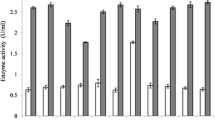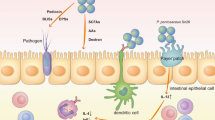Abstract
Probiotics are live microorganisms which are beneficial for the host when ingested at high enough concentrations. The methylotrophic yeast Pichia pastoris is widely used as heterologous protein production platform. However, its use as probiotic is poorly studied. The objective of this study was to evaluate some probiotic properties of the P. pastoris strain X-33 wild type. The resistance to in vitro and in vivo gastrointestinal conditions, stability in feed, safety, and antibacterial activity against Salmonella Typhimurium were evaluated. The yeast remained viable and persisted at appropriate concentration in the diet for at least 2 months, survived the stresses of the gastrointestinal tract in vitro and in vivo, caused no behavioral changes or lesions when administered to mice, inhibited the growth of S. Typhimurium in culture media, and reduced adhesion of the bacteria to the intestinal cells HCT-116. In the challenge experiment with a LD50 of virulent S. Typhimurium strain, mice supplemented with the yeast had a higher survival rate (50 % when administered by gavage and 80 % via the diet, compared with 20 and 50 %, respectively, in the control group). In addition, the S. Typhimurium concentration in the intestine of the surviving mice was lower; the score of intestinal lesions, lower; and the pathogen, not detected in the liver, spleen, and feces when compared to the control group (p < 0.05). It was concluded that the yeast Pichia pastoris X-33 has probiotic properties with remarkable antibacterial activity against S. Typhimurium.






Similar content being viewed by others
References
Blehaut H, Massot J, Elmer GW, Levy RH (1989) Disposition kinetics of Saccharomyces boulardii in man and rat. Biopharm Drug Dispos 10:353–364
Boddy AV, Elmer GW, McFarland LV, Levy RH (1991) Influence of antibiotics on the recovery and kinetics of Saccharomyces boulardii in rats. Pharm Res 8:796–800
Brandao RL, Castro IM, Bambirra EA, Amaral SC, Fietto LG, Tropia MJ, Neves MJ, Dos Santos RG, Gomes NC, Nicoli JR (1998) Intracellular signal triggered by cholera toxin in Saccharomyces boulardii and Saccharomyces cerevisiae. Appl Environ Microbiol 64:564–568
Bron PA, Van Baarlen P, Kleerebezem M (2012) Emerging molecular insights into the interaction between probiotics and the host intestinal mucosa. Nat Rev Microbiol 10:66–78. doi:10.1038/nrmicro2690
Çelik E, Ozbay NE, Çalik P (2008) Use of biodiesel byproduct crude glycerol as the carbon source for fermentation processes by recombinant Pichia pastoris. Ind Eng Chem Res 47:2985–2990. doi:10.1021/ie071613o
Conway P (1996) Selection criteria for probiotic microorganisms. Asia Pac J Clin Nutr 5:10–14
Cregg JM, Barringer KJ, Hessler AY, Madden KR (1985) Pichia pastoris as a host system for transformations. Mol Cell Biol 5:3376–3385
Cregg JM, Cereghino JL, Shi J, Higgins DR (2000) Recombinant protein expression in Pichia pastoris. Mol Biotechnol 16:23–52
Czerucka D, Roux I, Rampal P (1994) Saccharomyces boulardii inhibits secretagogue-mediated adenosine 3′,5′-cyclic monophosphate induction in intestinal cells. Gastroenterology 106:65–72
Czerucka D, Dahan S, Mograbi B, Rossi B, Rampal P (2000) Saccharomyces boulardii preserves the barrier function and modulates the signal transduction pathway induced in enteropathogenic Escherichia coli-infected T84 cells. Infect Immun 68:5998–6004
Czerucka D, Piche T, Rampal P (2007) Review article: yeast as probiotics—Saccharomyces boulardii. Aliment Pharmacol Ther 26:767–778
Drago L, Gismondo MR, Lombardi A, de HC, Gozzini L (1997) Inhibition of in vitro growth of enteropathogens by new Lactobacillus isolates of human intestinal origin. FEMS Microbiol Lett 153: 455–463
Duc lH, Hong HA, Barbosa TM, Henriques AO, Cutting SM (2004) Characterization of Bacillus probiotics available for human use. Appl Environ Microbiol 70:2161-2171. doi:10.1128/AEM.70.4.2161-2171.2004
Erkkila S, Petaja E (2000) Screening of commercial meat starter cultures at low pH and in the presence of bile salts for potential probiotic use. Meat Sci 55:297–300
Fang LC, Li Y, Cheng P, Deng J, Jiang LL, Huang H, Zheng JS, Wei H (2012) Characterization of Rhodopseudomonas palustris strain 2C as a potential probiotic. Acta Pathol Microbiol Immunol Scand 120:743–749. doi:10.1111/j.1600-0463.2012.02902.x
FAO/WHO. Guidelines for the evaluation of probiotics in food. FAO/WHO.Food and Agriculture Organization/World Health Organization. [Food and Agriculture Organization/World Health Organization.], 1–11. 2002. London
Fuller R (1989) Probiotics in man and animals. J Appl Bacteriol 66(5):365–378
Garcia-Hernandez Y, Rodriguez Z, Brandao LR, Rosa CA, Nicoli JR, Iglesias AE, Perez-Sanchez T, Salabarria RB, Halaihel N (2012) Identification and in vitro screening of avian yeasts for use as probiotic. Res Vet Sci 93:798–802. doi:10.1016/j.rvsc.2011.09.005
Gil de Los Santos, JR, Storch, OB, Fernandes, CG, Gil-Turnes, C (2012) Evaluation in broilers of the probiotic properties of Pichia pastoris and a recombinant P. pastoris containing the Clostridium perfringens alpha toxin gene. Vet. Microbiology. 156(3–4):448-451. doi:10.1016/j.vetmic.2011.11.019
Jain S, Yadav H, Sinha PR, Naito Y, Marotta F (2008) Dahi containing probiotic Lactobacillus acidophilus and Lactobacillus casei has a protective effect against Salmonella enteritidis infection in mice. Int J Immunopathol Pharmacol 21:1021–1029
Kaila M, Isolauri E, Soppi E, Virtanen E, Laine S, Arvilommi H (1992) Enhancement of the circulating antibody secreting cell response in human diarrhea by a human Lactobacillus strain. Pediatr Res 32:141–144
Le Blanc AM, Castillo NA, Perdigon G (2010) Anti-infective mechanisms induced by a probiotic Lactobacillus strain against Salmonella enterica serovar Typhimurium infection. Int J Food Microbiol 138(3):223–231. doi:10.1016/j.ijfoodmicro.2010.01.020
Love KR, Politano TJ, Panagiotou V, Jiang B, Stadheim TA, Love JC (2012) Systematic single-cell analysis of Pichia pastoris reveals secretory capacity limits productivity. PLoS One 7. doi:10.1371/journal.pone.0037915
Martins FS, Barbosa FHF, Penna FJ, Rosa CA, Nardi RMD, Neves MJ, Nicoli JR (2005) Estudo do potencial probiótico de linhagens de Saccharomyces cerevisiae através de testes in vitro. Rev BioCie Terra ISSN 1519–5228 5(2):1–13
Martins FS, Veloso LC, Arantes RM, Nicoli JR (2009) Effects of yeast probiotic formulation on viability, revival and protection against infection with Salmonella enterica ssp. enterica serovar Typhimurium in mice. Lett Appl Microbiol 49(6):738–744. doi:10.1111/j.1472-765X.2009.02732.x
Martins FS, Dalmasso G, Arantes RM, Doye A, Lemichez E, Lagadec P, Imbert V, Peyron JF, Rampal P, Nicoli JR, Czerucka D (2010) Interaction of Saccharomyces boulardii with Salmonella enterica serovar Typhimurium protects mice and modifies T84 cell response to the infection. PLoS One 5. doi:10.1371/journal.pone.0008925
Martins FS, Elian SD, Vieira AT, Tiago FC, Martins AK, Silva FC, Souza EL, Sousa LP, Araujo HR, Pimenta PF, Bonjardim CA, Arantes RM, Teixeira MM, Nicoli JR (2011) Oral treatment with Saccharomyces cerevisiae strain UFMG 905 modulates immune responses and interferes with signal pathways involved in the activation of inflammation in a murine model of typhoid fever. Int J Med Microbiol 301:359–364. doi:10.1016/j.ijmm.2010.11.002
Martins FS, Vieira AT, Elian SD, Arantes RM, Tiago FC, Sousa LP, Araujo HR, Pimenta PF, Bonjardim CA, Nicoli JR, Teixeira MM (2013) Inhibition of tissue inflammation and bacterial translocation as one of the protective mechanisms of Saccharomyces boulardii against Salmonella infection in mice. Microbes Infect 15(4):270–279. doi:10.1016/j.micinf.2012.12.007
Milette M, Luquet FM, Lacroix M (2007) In vitro growth control of selected pathogens by Lactobacillus acidophilus and Lactobacillus case in-fermented milk. Lett Appl Microbiol 44:314–319
Reed LJ, Muench H (1938) A simple method of estimating fifty percent endpoints. Am J Hyg 27:493–497
Rodrigues AC, Nardi RM, Bambirra EA, Vieira EC, Nicoli JR (1996) Effect of Saccharomyces boulardii against experimental oral infection with Salmonella Typhimurium and Shigella flexneri in conventional and gnotobiotic mice. J Appl Bacteriol 81:251–256
Saad SMI (2006) Probióticos e prebióticos: o estado da arte. Rev Bras Ciênc Farm 42:1–16
Santos DG, Gil-Turnes C, Conceição FR (2012) Bioremediation of parboiled rice effluent supplemented with biodiesel-derived glycerol using Pichia pastoris X-33. Sci World J. doi:10.1100/2012/492925
Santos RL, Zhang S, Tsolis RM, Kingsley RA, Adams LG, Baumler AJ (2001) Animal models of Salmonella infections: enteritis versus typhoid fever. Microbes Infect 3:1335–1344
Tiago FC, Martins FS, Rosa CA, Nard RMD, Cara DC, Nicoli JR (2009) Physiological characterization of non-saccharomyces yeasts from agro-industrial and environmental origins with possible probiotic function. World J Microbiol Biotechnol 25:657–666
Torres FAG, Moraes LMP (2000) Proteínas recombinantes produzidas em leveduras. Biotechnol Cien Desenv 12:20–22
Truusalu K, Mikelsaar RH, Naaber P, Karki T, Kullisaar T, Zilmer M, Mikelsaar M (2008) Eradication of Salmonella typhimurium infection in a murine model of typhoid fever with the combination of probiotic Lactobacillus fermentum ME-3 and ofloxacin. BMC Microbiol 8:132. doi:10.1186/1471-2180-8-132
Vieira LQ, Oliveira MR, Neumann E, Nicoli JR, Vieira EC (1998) Parasitic infections in germfree animals. Braz J Med Biol Res 31:105–110
Acknowledgments
The authors thank professors Odir A. Dellagostin and Vinicius F. Campos for their contribution. They are also indebted to the Brazilian Council for Scientific and Technological Development (CNPq) and Brazilian Federal Agency for Support and Evaluation of Graduate Education (Capes) for funding the project.
Conflict of interest
The authors declare that they have no competing interests.
Author information
Authors and Affiliations
Corresponding author
Rights and permissions
About this article
Cite this article
França, R.C., Conceição, F.R., Mendonça, M. et al. Pichia pastoris X-33 has probiotic properties with remarkable antibacterial activity against Salmonella Typhimurium. Appl Microbiol Biotechnol 99, 7953–7961 (2015). https://doi.org/10.1007/s00253-015-6696-9
Received:
Revised:
Accepted:
Published:
Issue Date:
DOI: https://doi.org/10.1007/s00253-015-6696-9




